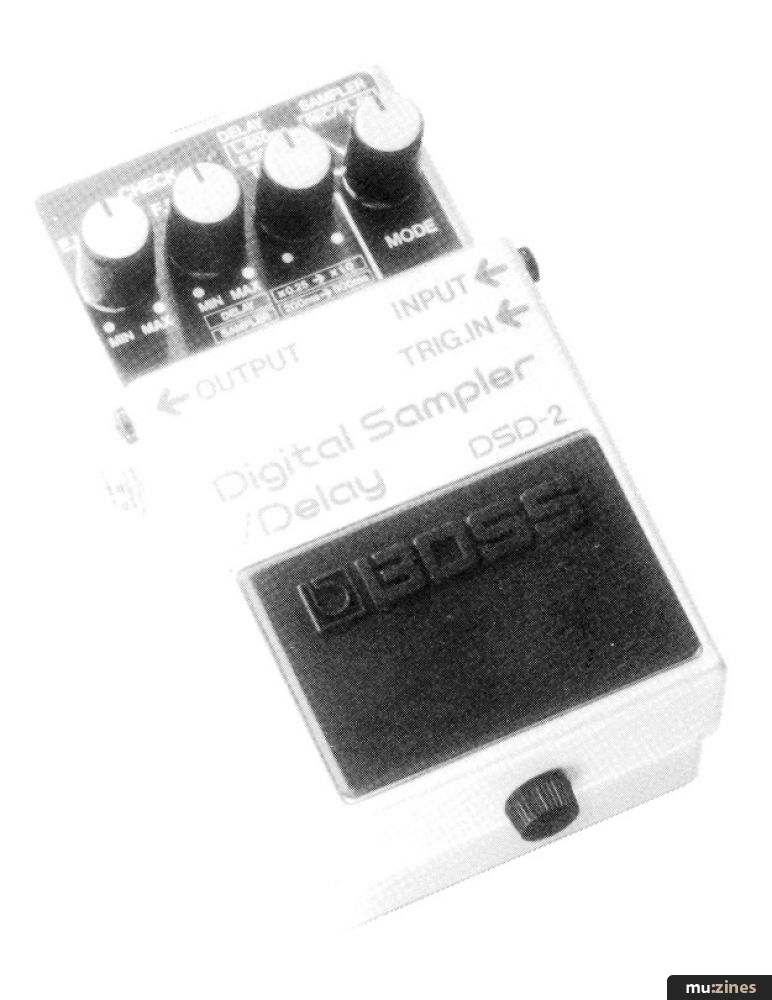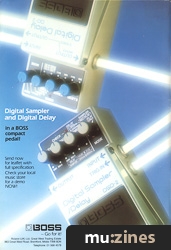Magazine Archive
Home -> Magazines -> Issues -> Articles in this issue -> View
Boss DSD-2 Digital Sampler | |
EffectscheckArticle from International Musician & Recording World, August 1985 | |
A simple delay pedal at first glance but Dave Burrluck discovers its true possibilities

It's not too often that I get excited about effects pedals these days; most sound the same and the quality is generally reflected in the price. However, when this Boss pedal popped in for the once-over I must admit to taking more than my usual interest. A digital sampler and delay for £200 sounds pretty good, I said, checking my bank statement.
For a change I thought I'd nip down to my local (studio that is) to enlist the help of Mike Westergaard (who has just installed a Greengate DS3 at his own Studio 99), as well as having my usual dabble with a Drumatix, Steinberger (not mine unfortunately) and trusty (not rusty) Strat.
Physically the DSD-2 is pretty similar to the DD-2 with basically the same control layout of effect level, feedback and (delay or sampling) time. The mode control has four positions, short delay (50-200ms), long (200ms-800ms) delay, sample record and sample play. There is a mono output jack which serves as a power switch when battery power is being used and an input and trigger, both sensibly ¼" sockets.
Certainly there isn't anything complicated about the DSD-2 — that is, until you start exploring its possibilities.
Firstly as a straight delay pedal it is very good. The delay time is not as short as the DD-2 which goes down to 12.5ms but I don't think there will be any qualms about the quality of the delay; in fact Mike reckoned that the bandwidth was higher than the actual specification of 7kHz. To cloth ears like you and me that means that all the high notes sound really clear!
But I don't think we should dwell on the delay side of things too much, let's get on to the main selling point of this pedal — the s-s-s-sam-sam-sampling (blast that stutter). The maximum sampling time is 800ms which is fine, plenty long enough for 'short sound' applications such as drums, percussion and one or two word spoken phrases. In fact I found that the sample time could be reduced for bass drum and snare sounds and a certain amount of experimentation is required so that you get no 'after sounds' on your sample.
How do you sample? Easy. Set the effect level to max (this ensures that the sample is recorded and replayed at the same level), the feedback to minimum and the time to match the length of your proposed sample. Set the mode selector to record, then hit the pedal and quickly release it. Turn the mode selector to play, hit the pedal again and whatever you have 'captured' comes back singly or repeated if you hold the pedal down.
Now the trick with sampling is to get the sound exactly at the start of the available time. If there is a gap at the start the sound will be off beat when triggered and obviously if you've hit the button too late you won't get the start of the sound — 'ex' as opposed to 'sex', if you see what I mean.
With sophisticated sampling devices such as the Greengate DS3 and the Bel you can remove any gaps before your sound after you've sampled it — with the DSD you can't. Obviously you have to get it right, especially if you're using an external trigger. This, of course is achieved with the extremely frustrating method of trial and error. The technique used on the DS3, for example, is the same as the 'drop in' principal — you hit the recording button very slightly before you play the sound to be sampled. With the DSD, however, trying this method had both Mike and myself doubting that the samples could be triggered without a delay or offbeat occurring. I then tried sampling a bass guitar by playing the note and hitting the pedal (with my foot I might add) simultaneously, which theoretically meant that I'd clip the start of the sample but in practice 99% of the time it worked perfectly. The sample was unclipped and, when triggered from a Drumatix, it was on beat. With that problem sussed you're home and dry and if there was a noticeable delay in the triggering of the pedal it would be redundant for most serious applications.
The next thing to check is the quality of the sampled sound which was, frankly, brilliant. When sampling a sound with a pure wave form such as a tom, you're likely to get hiss or noise at the end of the sample, known in the biz as quantisation noise. This is certainly the case with the DS3. With this pedal you don't. Any sound we sampled in, came back the same, which was quite a surprise.
Okay, with the basics of the pedal covered in terms of quality and triggering, what can you do with it? Well just about anything. Certainly you can create a drum track, so long as you can sync your drum machine off-tape or alternatively, if you have separate outputs on your Drumatix and have recorded the bass drum and snare on different tracks, you can replace either with a sound sampled into the DSD by triggering directly off tape. Of course the DSD has no facility to store any sounds other than the one you've sampled in, so it would be advisable to record your sounds on tape prior to sampling them. Here you could build up a library of recorded sounds, ie LinnDrum, TR-707 etc and have at your disposal an endless array of possibilities. Of course, building up drum tracks voice by voice is a long process and a mite frustrating bearing in mind the trial and error method of sampling, but it is possible.
You can also alter the pitch of your sample by rotating the time knob after you've sampled a sound, making tom rolls possible, albeit rather unpredictable with a single tom sample. It wouldn't, for example, be possible to play the DSD accurately, but if you sample in a snare with the time not set on full then you can deepen the sound on playback. Obviously this time knob enables you to tune your sample to a track depending on its length.
My only criticism is that the DSD has been designed as a foot pedal. The action of the switch isn't exactly touch sensitive and bearing in mind you have to change the mode selector each time you want to rec/play a sample, it would seem a more useful thing to have a touch-sensitive button on the unit with an auxiliary floor switch. This would improve the process of sampling and also mean that if you're working alone and your only option is to activate the unit by foot you won't keep having to bend up and down to check your sample.
Don't forget either, the delay side of the pedal which, while being nothing new, is extremely good and is also capable of 'overlay' techniques and the delay time once again being triggered from a drum machine.
For any musician with studio facilities the DSD-2 is a must — single sound sampling and digital delay for £200 is excellent value for money. As a foot pedal for live work, its real application would be as a delay — you couldn't really mess around sampling in mid-gig, but because of the strength of each function it makes an ideal item for a split purchase between a studio buff and a live-workaholic.
Don't delay, sample the DSD-2 now!
For: Ease of use; high quality
Against: Pedal switch seriousapplications.
BOSS DSD-2 DIGITAL SAMPLER/DELAY - RRP: £200
Also featuring gear in this article
Boss DSD-2
(12T Aug 85)
Boss DSD2
(EMM Oct 85)
Pedal Power - Boss DSD2 Sampler/Delay
(HSR Nov 85)
Two Into One - DSD-2
(ES Aug 85)
Browse category: Guitar FX > Boss
Publisher: International Musician & Recording World - Cover Publications Ltd, Northern & Shell Ltd.
The current copyright owner/s of this content may differ from the originally published copyright notice.
More details on copyright ownership...
Review by Dave Burrluck
Help Support The Things You Love
mu:zines is the result of thousands of hours of effort, and will require many thousands more going forward to reach our goals of getting all this content online.
If you value this resource, you can support this project - it really helps!
Donations for May 2024
Issues donated this month: 0
New issues that have been donated or scanned for us this month.
Funds donated this month: £0.00
All donations and support are gratefully appreciated - thank you.
Magazines Needed - Can You Help?
Do you have any of these magazine issues?
If so, and you can donate, lend or scan them to help complete our archive, please get in touch via the Contribute page - thanks!









